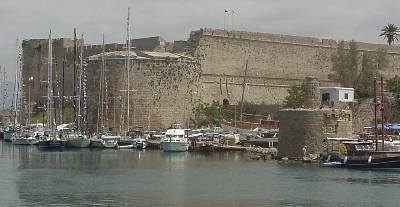 |
 |
 |
|
|
|
|
|
Neolithic people inhabited Cyprus as early as 10,000 BC, and
might have contributed to the extinction of the dwarf elephant and pygmy
hippopotamus. During the Bronze Age, copper was so associated with the
island that it isn't clear whether the island was named for the metal or
vice versa. Richard the Lionheart conquered the island in 1191 and sold it
after he'd robbed it of anything of value.
Kyrenia (or Girne) harbor is a jewel of a location, and our Rally boats filled it to overflowing. |
| Some of us were docked just outside the kale, or
castle. This castle was built by the Byzantines, and though it might have
withstood an Ottoman attack, the Venetians surrendered it in 1570 after they
saw how quickly Lefkosia (Nicosia) had fallen.
Inside, the castle rooms now exhibit Cyprus history. One room contains a recovered shipwreck of a trading vessel that had made its final voyage in about 300 BC. Other rooms display artifacts from Neolithic villages around the island. |
 |
|
|
Construction of the castle pictured at left, called Saint Hilarion, began in the tenth century to commemorate a man who had fled the Holy Land and lived in a cave in these mountains. The castle was expanded over the years by medieval ruler Guy de Lusignan and others. Locals say that Walt Disney visited this castle and became inspired to build Disneyland. Others say that only a hundred rooms have already been found on the site, and that the person who finds the hundred-and-first will become invisible. Thirty-four hundred paces took us up to the top of the castle. |
| The ancient city of Salamis was first mentioned on an
Assyrian grave stele in 709 BC. It was most important in the sixth century
BC, issuing its own currency and fostering intellectual thought. Greek poets
visited its royal courts routinely.
In 306 BC, the Persians destroyed the city and it fell under Ptolemaic rule until the Romans took over and brought it back to glory. Much of the city is still available for exploring. The theater, which purports to hold 15,000, is still in good shape, and the baths and latrines are still very recognizable. |
 |